
 |
 |
Replacement
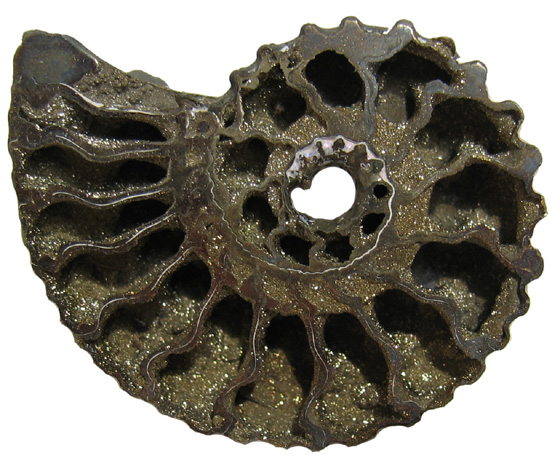 Pyritized Ammonite Jurassic Russia |
|
Minerals can replace bone, shell, wood, and even soft body parts as they dissolve away due to the action of water and decay. Replacement and mineralization are terms used to describe this fossilization process (Garcia & Miller, 1998, p. 15). Part of the ammonite shell above has been replaced by the mineral pyrite. The replacement of soft or hard body parts may occur when minerals precipitate out of solution due to the action of bacteria or pH changes. During replacement coats of bacteria quickly mineralize the decaying tissue. If replacement results in a fossil that is completely articulated with three-dimensional fidelity the process is referred to as mineral replication (Grimaldi and Engel, 2005, p. 45). Grimaldi and Engel also classify permineralization as a type of mineral replication that is a result of microbial decay. Organic residue on compression fossils can be replaced by minerals leaving an impression coated with a mineral. Pyrite is a common replacement mineral. In pyritization sulfur reducing bacteria facilitate the precipitation of pyrite during decay. The Lagerstätten known as Beecher's Trilobite Bed in New York is famous for its pyritized trilobites. Both the exoskeleton and soft body parts, including, antennae, legs, muscles, and digestive tract, have been preserved with the mineral pyrite (Etter, 2002, p. 131). In the Orsten deposits of Sweden the meiofauna making up the paleoecosystem of a flocculent-layer just above the seabed is exquisitely preserved by phosphatization. Eyes, hairs, spines, muscle scars, joints, pores, and soft body parts have been preserved on miniature late Cambrian arthropods. Exoskeletal replacement and or coating by calcium phosphate occur only on specimens less than 2 mm is size. The Orsten Lagerstätten is important because it helps to deepen our understanding of arthropods as many larval stages are preserved (Tang, 2002, pp. 117-121). Exquisite examples of leaves, stems, cones, and seeds of Carboniferous plants along with animal life can be found in the Lagerstätten known as Mazon Creek, which is just 150 km southwest of Chicago, Illinois. The soft and hard parts of plants and animals are replaced with the mineral siderite (iron carbonate). Subtle pH changes created by the decaying body of the buried organism caused available iron carbonate to precipitate. Thus, the organism became its own nucleation site for the formation of a siderite nodule. When these nodules are split open, the fossil appears as a 3-D external cast and mold. Mold surfaces may be coated with kaolinite, pyrite, calcite or sphalerite. Plant material is sometimes covered with a carbonaceous film (Nudds & Selden, 2004, p. 120). Plant material from an Oligocene deposit preserved in barite- sand nodules can be found near the town of Steinhardt Germany. When split open some of these nodules reveal molds and casts of plant material replaced with the mineral barite (barium sulfate). The process that forms a concretion or nodule, which may contain a replacement fossil, is called authigenic cementation or authigenic mineralization (Prothero, 2004, p. 437; Cleal & Thomas, 2009, p. 7). Authigenic minerals grow in place rather than being transported or deposited. Thus, the concretions or nodules are found in the place they formed or in situ (Latin for "in the place"). | |
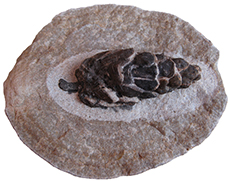 Conifer Cone in Barite Nodule Pinales Family Oligocene Steinhardt, Germany Cone is 6.5 cm long |
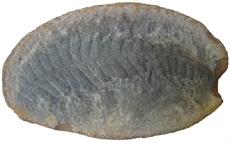 Fern (Pecopterid Group) in Siderite Nodule Asterotheca sp. Mazon Creek, Illinois Carbondale Formation, Francis Creek Shale Member Paleozoic; Pennsylvanian 10 cm long x 6 cm wide |
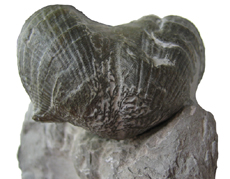 Pyritized Brachiopod Paraspirifer bownockeri Silica Formation Devonian Sylvania Quarry Lucas County, Ohio Note possible bryozoan on shell 5 cm long x 4.5 cm wide |
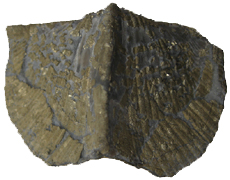 Pyritized Brachiopod Paraspirifer bownockeri Silica Formation Devonian Sylvania Quarry Lucas County, Ohio This specimen is acid etched |
 Baculite Marcasite Replacement Cretaceous Black Hills, South Dakota |
|
Bibliography |
|
| Cleal
C.J. & Thomas, B.A. (2009). Introduction to Plant
Fossils. United
Kingdom: Cambridge University Press. Etter, W.. (2002). Beecher's Trilobite Bed: Ordovician Pyritization for the Other Half of the Trilobite. In Bottjer, D.J., Etter, W., Hadadorn, J.W., & Tang, C.M. [Eds.] Exceptional Fossil Preservation: A Unique View on the Evolution of Marine Life (131-141). New York: Columbia University Press. Garcia,
F.A. & Miller, D.S. (1998). Discovering Fossils:
How to Find and Identify Remains of the Prehistoric Past.
Pennsylvania: Stackpole Books. Nudds, J.R. & Selden P.A. (2008). Fossil Ecosystems of North America: A Guide to the Sites and Their Extraordinary Biotas. Chicago: University of Chicago Press. Prothero,
D.R. (2004). Bringing Fossils to Life: An Introduction
to Paleobiology [2nd edition]. New York: McGraw-Hill. |
|










